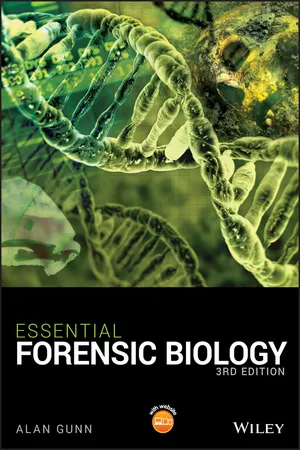
- English
- ePUB (mobile friendly)
- Available on iOS & Android
Essential Forensic Biology
About this book
A completely revised and updated edition that teaches the essentials of forensic biology, with increased coverage of molecular biological techniques and new information on wildlife forensics, wound analysis and the potential of microbiomes as forensic indicators
This fully revised and updated introduction to forensic biology carefully guides the reader through the science of biology in legal investigations. Full-colour throughout, including many new images, it offers an accessible overview to the essentials of the subject, providing balanced coverage of the range of organisms used as evidence in forensic investigations, such as invertebrates, vertebrates, plants and microbes. The book provides an accessible overview of the decay process and discusses the role of forensic indicators like human fluids and tissues, including bloodstain pattern analysis, hair, teeth, bones and wounds. It also examines the study of forensic biology in cases of suspicious death.
This third edition of Essential Forensic Biology expands its coverage of molecular techniques throughout, offering additional material on bioterrorism and wildlife forensics. The new chapter titled 'Wildlife Forensics' looks at welfare legislation, CITES and the use of forensic techniques to investigate criminal activity such as wildlife trafficking and dog fighting. The use of DNA and RNA for the identification of individuals and their personal characteristics is now covered as well, along with a discussion of the ethical issues associated with the maintenance of DNA databases.
- Fully revised and updated third edition of the successful student-friendly introduction to the essentials of Forensic Biology
- Covers a wide variety of legal investigations such as homicide, suspicious death, neglect, real and fraudulent claims for the sale of goods unfit for purpose, the illegal trade in protected species of plants and animals and bioterrorism
- Discusses the use of a wide variety of biological material for forensic evidence
- Supported by a website that includes numerous photographs, interactive MCQs, self-assessment quizzes and a series of questions and topics for further study to enhance student understanding
- Includes a range of important, key case studies in which the difficulties of evaluating biological evidence are highlighted
Essential Forensic Biology, Third Edition is an excellent guide for undergraduates studying forensic science and forensic biology.
Frequently asked questions
- Essential is ideal for learners and professionals who enjoy exploring a wide range of subjects. Access the Essential Library with 800,000+ trusted titles and best-sellers across business, personal growth, and the humanities. Includes unlimited reading time and Standard Read Aloud voice.
- Complete: Perfect for advanced learners and researchers needing full, unrestricted access. Unlock 1.4M+ books across hundreds of subjects, including academic and specialized titles. The Complete Plan also includes advanced features like Premium Read Aloud and Research Assistant.
Please note we cannot support devices running on iOS 13 and Android 7 or earlier. Learn more about using the app.
Information
Part I
Decay and the Discovery and Recovery of Human Remains
1
The Decay of Human Bodies
OBJECTIVES
1.1 Introduction
1.2 The Stages of Decomposition
1.2.1 Fresh
1.2.1.1 Temperature Changes
| Factors that enhance the rate of cooling Small body size Low fat content Body stretched out Body dismembered Serious blood loss Lack of clothes Wet clothes Strong air currents Low ambient temperature Rain, hail Cold, damp substrate that conducts heat readily (e.g. damp clay soil) Body in cold water Dry atmosphere |
| Factors that delay the rate of cooling Large body size High fat content Foetal position (reduces the exposed surface area) Clothing – the nature of clothing is important because a thin, highly insulated layer can provide more protection than a thick poorly insulated material. Insulated covering (e.g. blanket, dustbin bags, paper, etc.) Protection from draughts Warm ambient temperature Warm microclimate (e.g. body next to a hot radiator) Exposed to the sun Insulated substrate (e.g. mattress) High humidity |
Table of contents
- Cover
- Table of Contents
- Introduction
- Acknowledgements
- About the Companion Website
- Part I: Decay and the Discovery and Recovery of Human Remains
- Part II: DNA Analysis
- Part III: Body Tissues and Fluids and Wound Analysis
- Part IV: Invertebrates
- Part V: Vertebrates and Wildlife Crime
- Part VI: Plants, Protists, Fungi, and Microbes
- References
- Index
- End User License Agreement